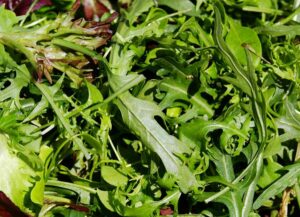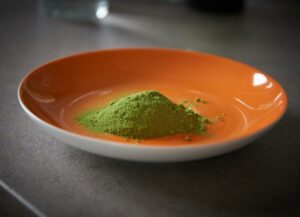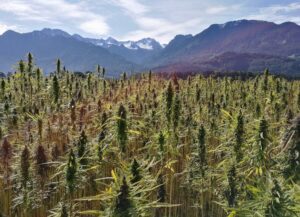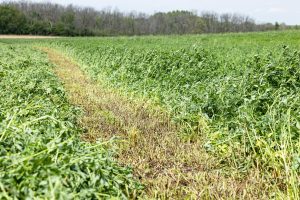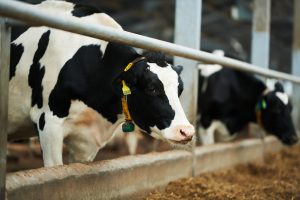María Villagrasa & Fernando Diaz
Jerusalem artichoke (Helianthus tuberosus L.) is a plant native to North America with very suitable characteristics to be used as livestock feed.
It belongs to the same genus as the sunflower with which easily interbreeds. The aerial portion can reach between 1.5 and 4.0 m in height and the underground growth is formed by an elongated and irregular tuber that slightly resembles the root of the ginger and has a taste similar to that of the artichoke. A distinctive feature of these tubers is that, unlike others, they store inulin (sugar made up of fructose units) instead of starch.
The nutritional composition of the aerial portion (stems, leaves and flowers) varies depending on the time of harvest. The protein content ranges from 5 to 23% dry matter basis while neutral detergent fiber (NDF) ranges between 30% to 50%. As far as the tubers are concerned, they are high in carbohydrates, especially fructosans such as inulin (50%), and sugars (27%). The CP content ranges from 5 to 12% and the NDF is approximately 9-10%.
Due to its high regrowth potential, it is possible to harvest artichoke three to four times a year. As noted above, the variation in the production and nutritional composition of tubers and the aerial part depends on the growth stage at which it is harvested.
In order to obtain more data on the effects of harvesting, a study (Farzinmehr et al., 2020) was conducted to assess how the frequency of harvesting (two, three or four times per year) of the artichoke affected the productivity and nutritional composition of tubers and its aerial parts.
Artichoke tubers were manually planted (24 February) in rows (20 to 25 cm apart) at 10 cm depth. Upon emergence (33 days post planting; March 27) the aerial part was harvested every 60, 90 or 120 days during the growing season (four, three and two harvests/year, respectively).
The plants were cut with a knife about five cm above ground and the tubers were harvested only once at the end of the growing season (late autumn), on plots with four, three and two harvests per year.
The largest total annual DM production was obtained when harvesting every 60 days
The largest production of the aerial portion (stems and leaves) was obtained in the first two harvests at 90 days (10.68 and 11.57 t DM/ha, respectively), and the lowest in the last 90 days (60 and 90 days (2.89 and 2.92 t DM/ha, respectively).
The stems and leaves harvested at 120 days contained the highest production of protein (average of 0.99 t/ha) and metabolizable energy (average of 81.1 × 103 MJ/ha), while the lowest production was observed in those harvested at 60 days (average of 0. 88 t/ha for protein and 60.0 × 103 MJ/ha).
As for tubers, the highest production of DM, protein, and ME (7.36 t/ha, 0.83 t/ha and 92.74 × 103 MJ/ha, respectively) was recorded when the harvest of the aerial parts took place every 120 days, and the lowest (4.87 t/ha, 0.51 t/ha and 59.41 × 103 MJ/ha, respectively) when the harvest was made every 60 days.
Considering the values of both the aerial and tuber the total annual production of DM, protein and ME reached their highest values (32.03t/ha, 4.08 t/ha and 399.9 × 103 MJ/ha, respectively) when harvesting every 60 days.
The protein content was reduced as the maturity of the plant increased
The aerial part DM oscillated between 14.6 and 25.1% of the fresh weight for plants harvested between 60 and 90 days, respectively. Moreover, the highest DM content in tubers was recorded in those collected at 120 days (25.4%) and the lowest in those collected at 60 days (21.2%).
As far as CP, plant maturity had an adverse effect on its concentration so that stems and leaves harvested at 90 and 120 days had the lowest protein concentrations (from 9.25 to 9.53%) compared to those collected at 60 days (12.2 to 14.5%).
On the other hand, as maturity progressed, concentrations of NDF, and lignin in the aerial parts increased. However, concentrations of protein, NDF, and lignin in tubers were not affected by the frequency of collection.
With regards to water-soluble carbohydrates (WSC) the aerial part contained 4.87 to 12.1%, with the lowest value in the 90-day harvest and the highest in the 60-day harvest. Maturity stage reduced WSC: the concentrations of stems and leaves collected at 60 days (average 9.96%) were higher than those collected at 120 days (average 6.84%).
As far as tubers were concerned, reducing harvesting frequency increased WSC concentration so that the highest concentration was observed in the tubers harvested at 120 days (59.1%).
Finally, nitrate concentration in the stems and leaves decreased with maturity, so the least amount of nitrate was observed in the 120-day harvest (average of 0.12%). Nitrates in the tuber were not affected by the plant’s harvesting frequency.
Conclusions
In short, the nutritional value of the Jerusalem artichoke declined as the plant matured.
- To achieve tubers with the highest annual productivity/ha and concentration of WSC it is recommended to harvest every 120 days.
- The highest nutritional value and increased productivity of the aerial parts was achieved by harvesting every 60 days.
- To obtain the highesttotal annual DM, protein, and energy from both tubers and aerial parts artichokes should beharvestedevery 60 days.
Reference
Farzinmehr, Somayeh & Rezaei, Javad & Fazaeli, Hassan. 2020. Effect of harvesting frequency and maturity stage of Jerusalem artichoke forage on yield, chemical composition and in vitro fermentation of the tubers and forage. Spanish Journal of Agricultural Research. 18. e0602. 10.5424/sjar/2020182-15379.
© 2020 Dairy Knowledge Center. All Rights Reserved.



